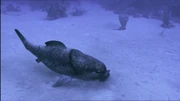
A baby Dunkleosteus.
Placodermi (from the Greek πλάξ = plate and δέρμα = skin, literally "plate-skinned") is an extinct group of paraphyletic armored prehistoric "fish" (Which are also paraphyletic, hence being in quotes.) , known from fossils, which lived from the Silurian to the end of the Devonian period, being done in by mass extinctions. Their head and thorax were covered by articulated armored plates and the rest of the body was scaled or naked, depending on the species. Placoderms were among the first jawed fish; their jaws likely evolved from the first of their gill arches. Placoderms are paraphyletic, and comprise several distinct outgroups or sister taxa to all living jawed vertebrates, which originated among their ranks. This is illustrated by a 419 MYA fossil, Entelognathus, from China, which is the only known placoderm with a type of bony jaw like that found in modern bony fishes. This includes a dentary bone, which is found in humans and other tetrapods.
Placoderms were also the first fish to develop pelvic fins, the precursor to hindlimbs in tetrapods, as well as true teeth.
380 MYA fossils of three other genera, Incistoscutum, Materpiscis and Austroptyctodus, represent the oldest known example of live birth.
Facts[]
The first identifiable placoderms appear in the fossil record during the late Llandovery epoch of the early Silurian.
The various groups of placoderms were diverse and abundant during the Devonian, but became extinct at the end-Devonian Hangenberg event 360 MYA.
In Walking with... Series[]
Sea Monsters []
Sea Monsters, Episode 1 & Sea Monsters, Episode 2 []
Those two episodes feature Dunkleosteus, one of the biggest and last placoderm fish. It is also the only fish to be featured by any of IP productions up to date. Dunkleosteus was the dominant predator of the Devonian seas, an arthodire placoderm, and a cannibal. It fed on everything, including its own young, but it still died out 360 MYA along with the other placoderms.
Sea Monsters had also featured Bothriolepis, a much smaller and far less dangerous placoderm fish. Unlike the giant Dunkleosteus, it was probably a filter-feeder rather than a scavenger, but it also died out by the beginning of the Carboniferous period.
Time map[]
It had a cameo on the time map.
